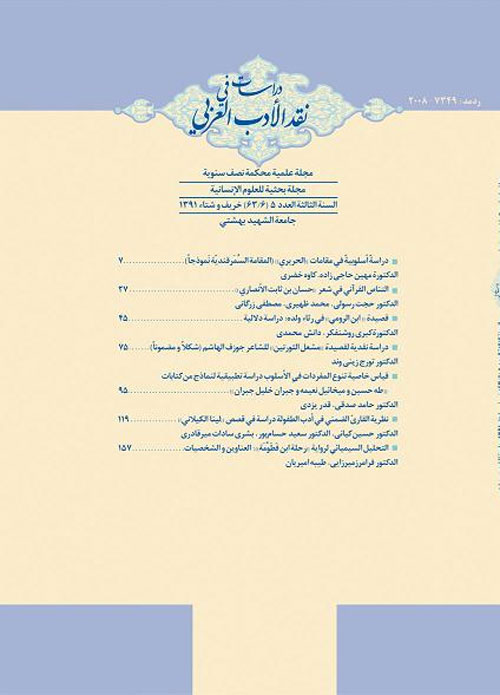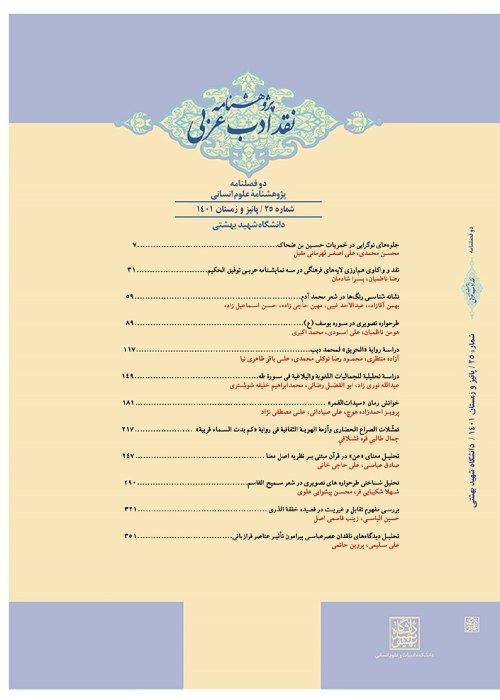فهرست مطالب

پژوهشنامه نقد ادب عربی
سال سوم شماره 5 (پاییز و زمستان 1391)
- تاریخ انتشار: 1391/10/25
- تعداد عناوین: 7
-
-
Stylistic study in Al-Hariri's Maqamat / (Study case: Al-Samarqandia Maqama)Page 7Arabic prose has been witnessed many revolutionary changes in styles form from long time ago, and then so many valuable literary essays has been produced. In the fourth century a new genre called Almaqama appeared. Al-maqama is an instance of the art in the Arabic prose. The purpose of this essay was beginner education at first, but after that it included the various contemporary knowledge which dealt with tales and anecdotes while not devoid of historical aspects and judgmental and literary. Al-Hariri's Maqamat is the most important literary form appeared in the Abbasid period after Badiuzzaman Alhamadani models and their number is fifty Maqama. All of them are drama and complex and all of them are full of dynamism in the doctrine of the artificiality and his contract.This article is a new attempt by the descriptive – analytical and is going to study the stylistic Al-Samarqandia Maqama based on the sound level, the combinational level and rhythmic level where researchers counted the sounds of the Maqama to determine the beauty of sound, phrases and rhythm aspects in this Maqama. The results indicate the rhythms in the Maqama and the proportionality between sounds and phrases with their concepts.Keywords: Maqamat, Al, Samarqandia Maqama, Stylistic, Al, hariri
-
Page 27Intertextuality is a critique process formulated by Julia Kristeva. This is a method which ended the text independence. Based on this method the critique of every text is derived from an older text. This method revolutionized the critique in the Arabic literature and attracted so many scholars’ attention. Regarding the role scripture play in the literary works, we can conclude that Muslim writers used frequently Qur’an in their works in order to make them stable and eternal. Hassân Ibn Sabēt alAnsarI, the poet of the Holy Prophet, considers the religious heritage of Arab as a significant source of Intertextuality in his poems. While examining his poems, it is perceived that he used sometimes the meaning and concept of the Koranic verse and at some other times he made use of the exact words to give a kind of elegance to his poems.Keywords: Quran, Intertextuality, Arabic literature, poem, Hassân Ibn Sabēt alAnsarI
-
Page 45Semiotic examination is attitude of new linguistics that analyses means of words, themes of words and respect between the word and its mean. ibne romis ode balladry of his boy is a masterpiece in old Arabic literature.This article tries to examine four levels of lexical, phonetic, syntactic and to discover semantic implications of balladry. Research findings show that the repetition of words such as “d” in rhymes of balladry and much USE for VERBAL sentences indicate severity of anxiety and sadness in poet. Also a high proportion of past tense verbs, implicate on belong of the poet to past more than present.Keywords: implies, Ibn Rumi, ode, implies phonetic, syntactic implications
-
Page 75Hosseinian epic has been resembled to the vital blood in the veins of Islamic nations and non-Islamic ones. Since before this epic has played an important role in the religious, cultural, political, social, and Islamic civilizations, and one of its affects was haunted in the approach of Arabian and Persian literature to overcome crulity, however, Arabian literature has composed some works in satire, Gazelle, and applauding.In this sense, there are many literary eminent collections such as “Adab Ailotf” (Ashuraian literature) in which poets have accepted Islam before. But some of non-muslems poets such as the Christian poets have composed some odes for Imam Hossein’s grief, and his revolution, one of them was called Jusef Al Hashem, a contemporary Lobnanian poet, he’s weaved both Christian reflections and Hosseinian values together. He is able to connect the values of Imam Hossein’s revolution and the spirit of freedom in Arabian nations especially Lobnan an Palestine. Regarding Imam Hossein’s goals, he has invited the Islamic, Arabian nations to resist Zionism. The main axeses of this study including: A) a preface about the general matters of study an introduction about the poet’s place, and a sumery of some of Christian, contemporary poets who have weaved the contemporary, Arabian literature and shieh literature. B) An analysis of Josef Al Hashem’s findings such his style in Ashuraian poems including mimic and innovative ways.Keywords: Imam Hossein, his followers, Ashuraian literature, Josef Al Hashem, the Christian poem, the resistance literature
-
Page 95Literary and critical studies in the late nineteenth century and the beginning of the twentieth century have changed into an independent discipline which is called stylistics. Stylistics applies the linguistic principles and methods to the study of the literary styles in an objective way. The diction of the poet is one of the most distinguished features of his style, which not only reflects his method and style but also the kind of sentences he writes. Therefore, it is expected that the study of the frequency of the words and diction in literary works indicates one of the most important features and distinguished qualities of the style. The researchers have attempted in this article to show which of the texts and samples studied have more variety of diction and how the writer has used the variety of diction in his work. The researchers also try to offer a theoretical framework for the study of the variety of an author’s diction, in the case of this study the selected works of Taha Hussein, Michael Naemah and Jubran Khalil Jubran. The study in this research is based on statistical stylistics. Following the selection of samples of texts and explaining the methods of evaluating the literary styles and analysis of the sample texts, the following results were achieved: the frequency of the variety of diction of Jubran Khalil Jubran was 33%, in Mikhael Naimah 40%, and in Taha Husein 32%. Moreover, this research shows that the average percent of the frequency and variety of diction in Jubran Khalil Jubran was 84% while this in Michael Naemah and Taha Hussein was respectively 74% and 67%.Keywords: statistical stylistics, variety of diction, Taha Hussein, Mikhael Naemah, Jubran Khalil Jubran
-
Page 157Semantic has always helped the reader find the internal Signs of the texts. Specially a text is fruitful. The novel of Ebn Fatoomehs Journey was written by Naguib Mahfouz- a famous Novelist.-The title of novel shows that writer has been influenced by heritage of Arabic literature intellectually and structurally. The same novel has been composed by mystical heritage in which suffists ask to access the truth. Structurally this novel has been influenced by literary heritage. In the light of semantics the writer concerns the titles characters names and settings because they concern the secret meanings. The novel of Ebn Fatoomehs Journey Includes a great deal of titles which are signified in the different ways. At first the title of novel is a key to solve the secrets of novel. The marginal titles are also signified the political intellectual social approaches (including Alvatan Dar Almashregh Dar Al Heirat Dar Alaman Dar Alghoroob Al Bedayat). Finally the characters of novel are signified by suffists thoughts conditions and their positions. All of these matters are appropriate with the writer's thoughts structurally which are visible in the novel.Keywords: Semantic, Naguib Mahfouz, Journey of Ebn Fatoomeh


